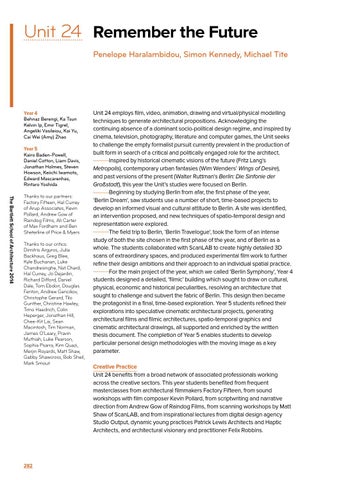Unit 24 Remember the Future Penelope Haralambidou, Simon Kennedy, Michael Tite
Year 4 Behnaz Berengi, Ka Tsun Kelvin Ip, Emir Tigrel, Angeliki Vasileiou, Kai Yu, Cai Wei (Amy) Zhao Year 5 Kairo Baden-Powell, Daniel Cotton, Liam Davis, Jonathan Holmes, Steven Howson, Keiichi Iwamoto, Edward Mascarenhas, Rintaro Yoshida The Bartlett School of Architecture 2014
Thanks to our partners: Factory Fifteen, Hal Currey of Arup Associates, Kevin Pollard, Andrew Gow of Raindog Films, Ali Carter of Max Fordham and Ben Sheterline of Price & Myers Thanks to our critics: Dimitris Argyros, Julia Backhaus, Greg Blee, Kyle Buchanan, Luke Chandresinghe, Nat Chard, Hal Currey, Jo Dejardin, Richard Difford, Daniel Dale, Tom Ebdon, Douglas Fenton, Andrew Gancikov, Christophe Gerard, Tilo Gunther, Christine Hawley, Timo Haedrich, Colin Heperger, Jonathan Hill, Chee-Kit Lai, Sean Macintosh, Tim Norman, James O’Leary, Pravin Muthiah, Luke Pearson, Sophia Psarra, Kim Quazi, Merjin Royards, Matt Shaw, Gabby Shawcross, Bob Sheil, Mark Smout
282
Unit 24 employs film, video, animation, drawing and virtual/physical modelling techniques to generate architectural propositions. Acknowledging the continuing absence of a dominant socio-political design regime, and inspired by cinema, television, photography, literature and computer games, the Unit seeks to challenge the empty formalist pursuit currently prevalent in the production of built form in search of a critical and politically engaged role for the architect. Inspired by historical cinematic visions of the future (Fritz Lang’s Metropolis), contemporary urban fantasies (Wim Wenders’ Wings of Desire), and past versions of the present (Walter Ruttman’s Berlin: Die Sinfonie der Großstadt), this year the Unit’s studies were focused on Berlin. Beginning by studying Berlin from afar, the first phase of the year, ‘Berlin Dream’, saw students use a number of short, time-based projects to develop an informed visual and cultural attitude to Berlin. A site was identified, an intervention proposed, and new techniques of spatio-temporal design and representation were explored. The field trip to Berlin, ‘Berlin Travelogue’, took the form of an intense study of both the site chosen in the first phase of the year, and of Berlin as a whole. The students collaborated with ScanLAB to create highly detailed 3D scans of extraordinary spaces, and produced experimental film work to further refine their design ambitions and their approach to an individual spatial practice. For the main project of the year, which we called ‘Berlin Symphony’, Year 4 students designed a detailed, ‘filmic’ building which sought to draw on cultural, physical, economic and historical peculiarities, resolving an architecture that sought to challenge and subvert the fabric of Berlin. This design then became the protagonist in a final, time-based exploration. Year 5 students refined their explorations into speculative cinematic architectural projects, generating architectural films and filmic architectures, spatio-temporal graphics and cinematic architectural drawings, all supported and enriched by the written thesis document. The completion of Year 5 enables students to develop particular personal design methodologies with the moving image as a key parameter. Creative Practice Unit 24 benefits from a broad network of associated professionals working across the creative sectors. This year students benefited from frequent masterclasses from architectural filmmakers Factory Fifteen, from sound workshops with film composer Kevin Pollard, from scriptwriting and narrative direction from Andrew Gow of Raindog Films, from scanning workshops by Matt Shaw of ScanLAB, and from inspirational lectures from digital design agency Studio Output, dynamic young practices Patrick Lewis Architects and Haptic Architects, and architectural visionary and practitioner Felix Robbins.
